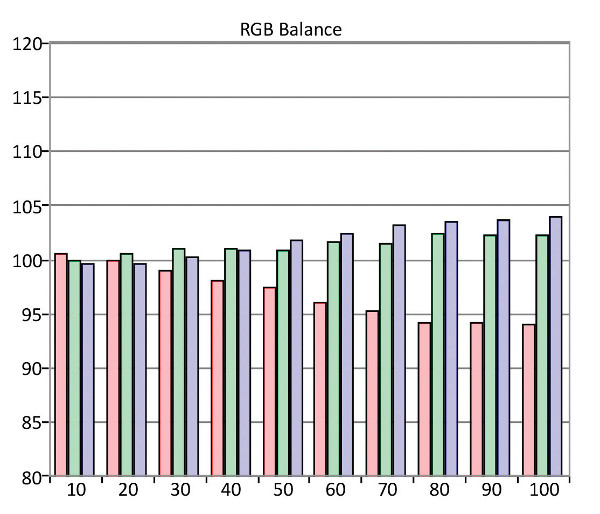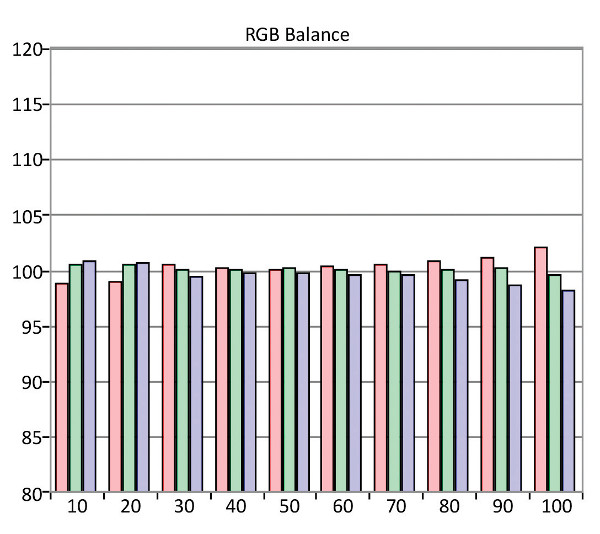JVC DLA-X790R D-ILA Projector Review Test Bench
Measurements were made with SpectraCal’s CalMAN software, Photo Research PR-650 and Klein K-10A color meters, and Murideo and DVDO pattern generators. The control settings I used are here. All measurements were taken at approximately 14 feet from a 96-inch-wide, 1.3-gain, Stewart Filmscreen StudioTek 130 screen.
(Delta E as referenced below is a figure of merit indicating how close the color comes to the standard at each point in the brightness range. Values below 3 — some experts allow for 4 — are generally considered visually indistinguishable from ideal.) The peak white reading for the contrast ratio was 22.78 ft-L (78.1 nits) and the black level 0.001 ft-L (0.0034 nit). At maximum zoom, the full-on/full-off contrast ratio measured 13,685:1; at minimum zoom, 33,370:1. The black levels measured 0.001 ft-L for all three; if our measuring gear could read to more than three digits past the decimal point, it might have been less!
In its default settings, the THX mode’s peak SDR brightness was 27.5 ft-L. During calibration, the iris was reduced to –4, for a more practical peak of 21 ft-L. (This differs slightly from the peak contrast levels cited above, due to the use of different test tools and procedures for the two measurements.)
For HDR, as viewed, the full-on/full off contrast ratio measured 21,765:1 at a peak white level of 43.53 ft-L (149.1 nits) and a black level of 0.002 ft-L (0.0069 nit).

Before SDR calibration (above) in the THX Picture Mode, the grayscale Delta Es ranged from a minimum of 1.14 at 20% to a maximum of 3.68 at 80%. After calibration, the minimum was 0.71 at 20% and the maximum 1.29 at 50%. The SDR color Delta Es were all below 2.0 either before or after calibration, so the CMS wasn’t used for SDR. After calibration (below), the EOTF (gamma) ranged from a maximum of 2.41 at 20% to a minimum of 2.3 at 70% and 80%.

Careful use of the available adjustments (particularly Picture Tone and Dark Level in the Gamma menu), with tools available to most calibrators, brought the HDR EOTF impressively close to the expected shape of an HDR10 PQ curve. Because of this, the Delta E errors, while not up to their SDR quality, were the best I’ve yet measured on a projector, dropping from a maximum value of approximately 28 at 50% to under 8 after calibration, luminance included. Without luminance, the maximum post-calibration Delta E was 4.2 at 50%.
The color points, after CMS calibration, were dramatically improved, to a maximum of 3.5 in magenta for all, except green at 9.0. But the green error was rarely noticeable, and never bothersome, on real program material.
As with all other UHD/HDR displays we’ve tested, the JVC falls well short of full coverage of the UHD standard's BT.2020 color gamut. UHD sources originally mastered in the DCI-P3 gamut still fell short of the P3 limits inside the BT.2020 color container, but that’s true of all the displays I’ve seen so far. As viewed, the JVC's color was more than impressive.

The peak HDR brightness on-screen increased slightly from 148.9 nits in a 10% window to 166.3 nits at 25% and above.—TJN
Note: The JVC clipped below black and above white when the Input Level control was in the preferred Auto setting, but it will pass those signals with Input Level set to Enhanced. See review text.




























































